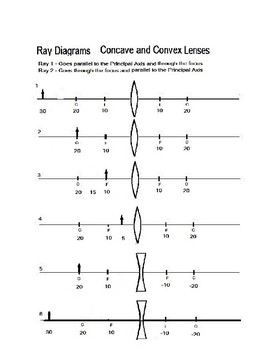Remember that science fair project where you built a pinhole camera? The way the light projected through the small hole created an image on the opposite wall was fascinating. That’s essentially what lenses do – they manipulate light, and that’s where ray diagrams come in. These diagrams are visual tools that help us understand how light behaves when it passes through lenses, whether it’s the simple magnifying glass or the complex lens in your camera. Understanding these diagrams is crucial for grasping the physics behind lenses. And today, we’re going to focus on converging and diverging lenses specifically.

Image: www.teacherspayteachers.com
This article will guide you through creating and understanding ray diagrams for converging and diverging lenses. Whether you’re a student tackling this topic in class or a curious individual interested in learning more about light and lenses, this comprehensive explanation will provide you with a clear understanding of these concepts.
Understanding Converging and Diverging Lenses
Converging and diverging lenses are the basic building blocks of optics. They’re classified by their ability to either bring light rays together (converging) or spread them out (diverging). These effects are due to the lens’ shape – a converging lens, typically thicker in the middle, converges light rays, while a diverging lens, thinner in the middle, diverges light rays.
Converging Lenses
Converging lenses, also known as convex lenses, are thicker in the middle than at the edges. They have the ability to focus light rays, creating real or virtual images depending on the position of the object.
Types of Ray Diagrams for Converging Lenses
There are three main types of rays used for constructing ray diagrams for converging lenses:
- Principal axis ray: This ray travels parallel to the principal axis and then passes through the focal point after refraction.
- Focal point ray: A ray passing through the focal point before hitting the lens will emerge parallel to the principal axis.
- Center of lens ray: A ray passing through the center of the lens continues in a straight line without refracting.

Image: studyfinder.org
Diverging Lenses
Diverging lenses, also known as concave lenses, are thinner in the middle than at the edges. They have the opposite effect of converging lenses – they spread out light rays, making them appear to diverge from a point called the focal point.
Types of Ray Diagrams for Diverging Lenses
Similar to converging lenses, we use three primary rays to construct ray diagrams for diverging lenses:
- Principal axis ray: A ray parallel to the principal axis will seem to originate from the focal point after refraction.
- Focal point ray: A ray traveling towards the focal point will emerge parallel to the principal axis.
- Center of lens ray: A ray passing through the center of the lens continues in a straight line without refracting.
Ray Diagrams: A Step-by-Step Guide
Drawing accurate ray diagrams is essential for understanding the behavior of light through lenses. Here’s a step-by-step process for constructing ray diagrams for both converging and diverging lenses:
- Draw the principal axis: A horizontal line representing the optical center of the lens.
- Draw the lens: Draw the lens as a curved line, either converging (thicker in the middle) or diverging (thinner in the middle).
- Locate the focal points: Mark the focal points (F) on either side of the lens. The distance between the lens and the focal point is called the focal length (f).
- Place the object: Draw an arrow to represent the object at a specific distance from the lens.
- Draw the rays: Draw three rays originating from the top of the object and following the rules described above.
- Find the image: The point where the rays intersect (for converging lenses) or appear to intersect (for diverging lenses) determines the location and size of the image.
Tips and Expert Advice for Master Ray Diagrams
Here are some tips to help you master the art of creating these scientific illustrations:
- Use a ruler and protractor: For accurate results, use a ruler and protractor to draw straight lines and measure angles.
- Practice makes perfect: The more ray diagrams you draw, the better you’ll become at understanding the concepts.
- Use different colors: Using different colors for different rays can help clarify your thinking.
- Label everything: Label everything clearly, including the lens, focal points, object, and image.
FAQ
What is the difference between a real and a virtual image?
A real image is formed when light rays actually converge at a point, and it can be projected onto a screen. A virtual image is formed when light rays appear to diverge from a point but do not actually intersect. It cannot be projected onto a screen.
How do I determine the magnification of the lens?
The magnification is the ratio of the height of the image (h’) to the height of the object (h): Magnification = h’/h. This value can be positive (upright image) or negative (inverted image).
What are some applications of converging and diverging lenses?
Converging lenses are used in telescopes, cameras, and eyeglasses for farsightedness. Diverging lenses are used in microscopes, eyeglasses for nearsightedness, and in some types of telescopes.
Converging And Diverging Lenses Ray Diagrams Worksheet Answers
Conclusion
Ray diagrams are essential tools for understanding how light interacts with lenses. By mastering the art of drawing these diagrams, you can gain a deeper insight into optics concepts like converging and diverging lenses, focal points, image formation, and magnification. Remember, practice is key! The more you draw, the better you’ll become at understanding and applying these concepts.
Are you intrigued by the world of optics? Do you have any questions about converging and diverging lenses or ray diagrams? Share your thoughts and ask away on the comment section below!






